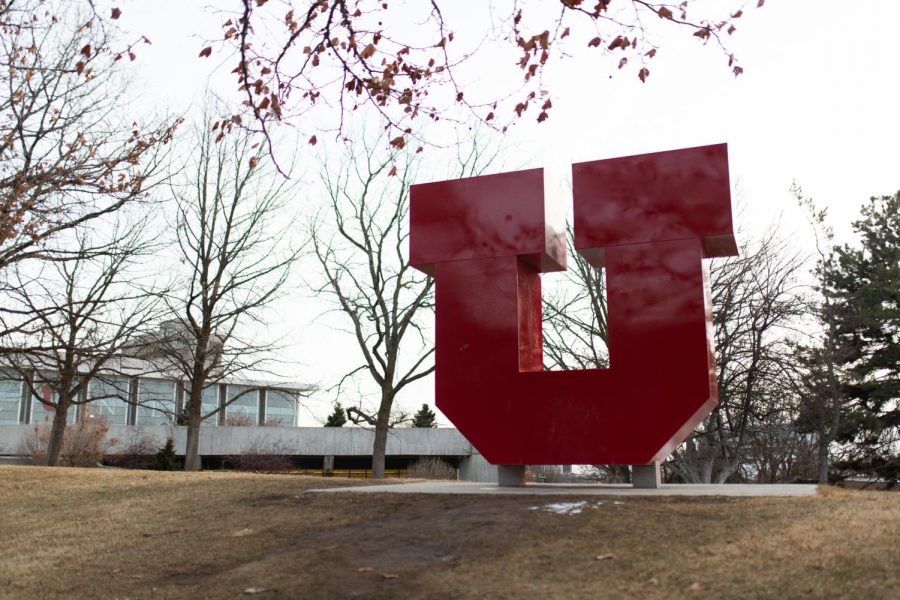U Professor’s Book Gathers Perspectives of Latter-day Saint Women Throughout the Years
Evening on University of Utah campus, Thursday in Salt Lake City. (Photo by Maya Fraser | The Daily Utah Chronicle)
April 16, 2023
The J. Willard Marriott Library hosted “Sister Saints: A Conversation About Modern Latter-day Saint Women” in the Gould Auditorium on April 5.
Author Neylan McBaine held an interview-style conversation with University of Utah History Professor Dr. Colleen McDannell about her October 2018 book, “Sister Saints.”
With the COVID-19 pandemic starting shortly after the book’s release, the university never got to hold an informational dialogue on “Sister Saints” until now.
Wednesday night served as an analysis of McDannell’s book and a fundraising opportunity for the Aileen H. Clyde 20th Century Women’s Legacy Archive, where much of the content in “Sister Saints” was found.
“In recognition of the complexity and change experienced by 20th century women in Utah and elsewhere, the mission of the Aileen H. Clyde 20th Century Women’s Legacy Archive is to document and preserve the history of women whose lives and work helped create social and cultural change,” says the archive’s webpage.
Historians like McDannell can visit the U library and see the archived books, letters and diaries. “Sister Saints” shares the testimonies of many women who are members of the Church of Jesus Christ of Latter-day Saints found in the archive, one being Ramona Cannon, better known as “Mary Marker.”
“I went into the archive and came across the name Ramona Cannon, who I knew only from the Ramona W. Cannon Award,” McDannell said.
Shortly after, McDannell found out Cannon was one of the first women in the state to receive a graduate degree in English and was known for her advice column with the Deseret News.
From 1947 until 1974, Cannon was sent letters from women in the greater Salt Lake area. Cannon used the alias “Mary Marker” to reply with candid responses to these letters in her advice column.
“These letters would range from, ‘I am looking to sell a sewing machine, where should I sell it?’ to ‘I’m thinking about getting pet rabbits, do you think that’s a good idea?’ to ‘I’m struggling with my husband and children, etc., etc.,'” McDannell said.
The U’s Clyde archive collected 1,400 of these letters that helped bring together the perspectives of different LDS women in McDannell’s book.
McDannell’s book also shares perspective from far before Cannon’s letters in 20th century. She also covers LDS women from the 19th century to the present day.
“We look at the pioneers, adventurers, feminists, civic organizers, writers, artists, ones raising families by themselves, to women in South Africa, to Cambridge, Mass., to Sandy, Utah and look at how their lives impacted the church,” McDannell said.
The Generations of Women Covered in “Sister Saints”
In the beginning, “Sister Saints” looked at the pioneer women who had a significant spiritual presence in the community, from speaking in tongues to healing, McDannell said.
“Women in the early church could influence the church through prophecy, blessings and even dreams,” McDannell said. “The elders would come to bless people, but so would the women elders, a both-and situation, not an either-or.”
The book covers stories from the end of polygamy in the 19th century through the turn of the century, McDannell said. It speaks to how women kept a good public face, but their diaries did not match.
“When you look at the diaries, you find they longed for their husbands, and they wanted to have relationships that were close and intimate,” McDannell said.
McDannell also explained that many women still supported polygamy during this period, expressing the biggest struggle was placed on the children of plural households.
“Mothers would say things like, well, ‘God loves all their children, so they can love all their wives, living in a plural household allows us to sacrifice and share,'” McDannell said.
McDannell discussed the Relief Society, a fully women-facilitated organization within the LDS church founded in 1842 where women engage in civil work, education and technical fields.
Around the turn of the century, the elders in the church allowed the relief society women to open their own building if they could fundraise for it, McDannell explained.
The women worked hard but fell short of the fundraising goals from not working at wage labor, McDannell said. Women were organizing egg sales, making quilts and doing anything to make the money.
“This was a turning point in the church because the women felt really defeated, and the male elders quickly opened up a building for themselves, claiming the women were just dithering around,” McDannell said.
In 1952, Cannon received a letter for her Deseret News advice column addressing perfectionism in the church, McDannell said.
The letter talked about the pressure from the church to have the perfect kids, husband and life.
“We see a lot of parallels from the women who wrote in diaries to the women in the LDS church today,” McDannell said.
McDannel expands on many stories of women struggling with perfectionism throughout the years and encourages everyone to look at religion culturally.
“The LDS women in South Africa can look at it as a positive religion for women because it asks men to be active in the home,” McDannell said. “… LDS women in Utah have different problems than the LDS women in the Southern Hemisphere.”
Hal Clyde, the grandson of Aileen H. Clyde, recalled many experiences as a young kid where he would go to events with his grandmother and where he was in the same room as so many important faces in Utah history.
“Rooms like these are the ones Aileen would love, so many powerful and intelligent women,” Clyde said. “We hope the … [archive] will lift the voices of more incredible women.”








